Daily Current Affairs for UPSC
Indigenous Prototype Fast Breeder Reactor (PFBR)
Syllabus- Science and Technology [GS Paper-3]

Context
Prime Minister of India has recently witnessed the initiation of the core loading of India’s indigenous 500 Mwe Prototype Fast Breeder Reactor (PFBR) at the Madras Atomic Power Station, Kalpakkam.
About PFBR
- PFBR was built and operated by Bharatiya Nabhikiya.
- The government authorized the introduction of Bharatiya Nabhikiya Vidyut Nigam Ltd (BHAVINI) in 2003.
- The PFBR is a system that produces more nuclear fuel than it consumes.
The Salient Feature of the Reactor
- The Fast Breeder Reactor (FBR) will initially use the Uranium-Plutonium Mixed Oxide (MOX) fuel.
- The Uranium-238 “blanket” surrounding the fuel center will undergo nuclear transmutation to produce more fuel, hence incomes the call ‘Breeder’.
- The use of Thorium-232, which in itself isn’t a fissile material, as a blanket is also envisaged on this stage.
- By transmutation, Thorium will create fissile Uranium-233 with the intention to be used as fuel in the third stage.
Significance of the Fast Breeder Reactor
- FBR is a stepping stone for the third stage of the program paving the way for the eventual full utilization of India’s plentiful thorium reserves.
- It can produce more fuel than it consumes, as a result helping in achieving self-reliance in fuel supply for future fast reactors.
- It is an advanced third-generation reactor with inherent passive safety features, ensuring a set off and secure shutdown of the plant in an emergency.
- Since it uses spent fuel from the first stage, FBR also offers a bonus in a huge reduction on nuclear waste generated.
- Once commissioned, India can be the second country after Russia to have a commercially running fast breeder reactor.
India’s Three-stage Nuclear Program
- Homi J. Bhabha designed the 3-stage programme as India has confined home uranium resources however has plentiful Thorium.
- The 3 tiers are predicted to permit the country complete self-sufficiency in nuclear power.
- First Stage (Pressurized Heavy Water Reactors – PHWRs): India’s nuclear application to begin with targeted on setting up a fleet of PHWRs.
- These reactors use natural uranium (U-238), which includes minuscule quantities of U-235, as the fissile material.
- Heavy water (deuterium oxide) as each moderator and coolant.
- The primary reason for this stage was to provide plutonium-239 as a byproduct from the uranium fuel.
- Plutonium-239 is a fissile material used as fuel in nuclear reactors.
- Second Stage (Fast Breeder Reactors – FBRs): The 2d stage of this system entails the deployment of Fast Breeder Reactors (FBRs).
- FBRs are designed to provide more fissile material than they consume by means of making use of a fast neutron spectrum.
- In this stage, plutonium-239 produced in the first stage is used as fuel at the side of U-238 to supply strength, U-233, and more Pu-239.
- Uranium-233 is any other fissile material that may be used as fuel in nuclear reactors.
- Third Stage (Advanced Heavy Water Reactors – AHWRs): The very last stage of this system includes the deployment of Advanced Heavy Water Reactors (AHWRs).
- Pu-239 may be mixed with thorium-232 (Th-232) in reactors to produce strength and U-233.
- Thorium is abundantly available in India, and this stage aims to harness its potential as a nuclear fuel.
Source: The Hindu
UPSC Mains Practice Question
Q.Energy is the most fundamental requirement of every nation as it progresses through the ladder of development. In the light of the statement discuss the role of nuclear energy. (250 Words)





.png)



